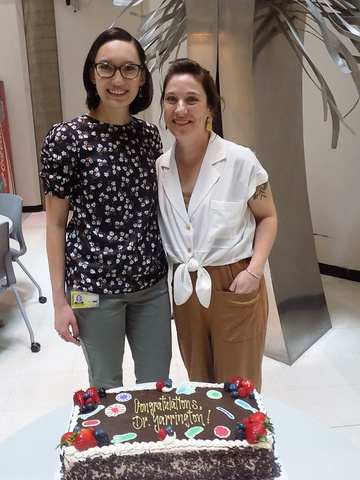
Kaitlin Yarrington successfully defended her PhD thesis, entitled "c-di-GMP fine-tunes the Pil-Chp system to control type IV pilus-mediated interspecies chemotaxis" on Tuesday, June 4, 2024. This significant milestone in her academic journey was celebrated with her mentor, Dominique Limoli, PhD. Kaitlin is pictured on the left in the photo.
Research
Bacteria must be able to sense and respond to interspecies and environmental signals to survive in their complex communities. We have observed that the opportunistic pathogen Pseudomonas aeruginosa detects secreted peptides from bacterial competitors, like Staphylococcus aureus, and navigates through interspecies signal gradients using type IV pilus (TFP)-based motility. Yet, it was unknown whether P. aeruginosa utilizes a designated chemosensory system for this behavior. Here, I performed a systematic genetic analysis followed by high-speed live-imaging and single-cell tracking, to reveal behaviors of mutants that retain motility but are blind to interspecies signals.
From my studies, I uncovered two pathways necessary for P. aeruginosa to sense and respond to secreted peptides from S. aureus: 1) Pil-Chp, a putative TFP chemotaxis system and 2) second messengers cyclic adenosine monophosphate (cAMP) and cyclic diguanosine monophosphate (c-di-GMP). Specifically, I found that the ligand binding domain of the Pil-Chp chemoreceptor, PilJ, and other PilJ-associated proteins, including CheW-like linker, ChpC, and chemotaxis adaptation proteins, ChpB and PilK are required to fully respond to S. aureus. Together, these proteins pointed towards an important role in sensing signals by Pil-Chp.
In addition, I found that cAMP levels increased, while population levels of c-di-GMP remained unchanged during TFP chemotaxis. Yet, I identified a subset of enzymes (SiaD, PA2870, BifA, and MorA) for regulating c-di-GMP levels as well as two c-di-GMP effector proteins (PA0012 and PA2989) that were each critical for chemotaxis. These effectors directly target TFP retraction and PilJ-associated proteins in the Pil-Chp pathway. I predict these interactions fine-tune TFP extension and retraction events in response to sensed chemoeffectors to bias movements up signal gradients without changing global c-di-GMP levels. Collectively, the work in this thesis not only dissects pieces of the complex bacterial c-di-GMP network, but also contributes to understanding how bacteria adapt to complex environments with other species and provides putative pathways where therapeutic intervention might disrupt bacterial communication that is harmful to patients.
Background
Kaitlin was born and raised in Inver Grove Heights, Minnesota, the oldest of two daughters to Mark and Cindy Yarrington. Throughout her high school career, science classes were always her least favorite. Though planning to avoid science forever, Kaitlin enrolled in an introductory biology course during her first semester as an undergraduate at Wheaton College in Illinois and quickly realized how exciting biology could be. A year later, Kaitlin took a research methods class and immediately fell in love with research from planning and executing experiments, to data analysis and generation of new ideas to test in the lab. This led Kaitlin to the lab of Dr. Vanya Tepavčević, where she spent her last two undergraduate years studying the roles of sRNA chaperones in motility, biofilm formation, and bioluminescence of the marine bacterium, Vibrio fischeri. Through this research experience, as well as her time in a summer undergraduate research program at the University of Iowa, Kaitlin quickly realized that she wanted to make research a permanent career and returned to the University of Iowa to join the Graduate Program in Microbiology in 2018.
In the spring of 2019, Kaitlin joined the lab of Dr. Dominque Limoli, where she has since had the opportunity to investigate polymicrobial interactions between the bacterial species, Pseudomonas aeruginosa and Staphylococcus aureus. In particular, she has spent much of her time learning about how bacteria can sense other species in their environments and move towards them, through a process called chemotaxis. Through her thesis work, Kaitlin has gained a greater appreciation for the importance of studying interspecies communities and has loved dissecting the intricate pathways that P. aeruginosa utilizes to chemotax towards S. aureus. She is also thankful for the opportunities she has had to research and collaborate with so many amazing scientists along the way.
Upon completion of her PhD, Kaiti will move to the University of Oregon for her postdoctoral work in the labs of Drs. Danielle Benoit and Karen Guillemin, where she plans to investigate how oral bacterial species contribute to colon and pancreatic cancers, both alone and when part of polymicrobial communities.
Outside of the lab, Kaitlin can often be found rock climbing at the CRWC and hanging out with friends at coffee shops, on walks, or over video chat. During her time in Iowa City, she has also enjoyed serving coffee at Parkview church and helping with various STEM outreach events with the Department of Microbiology and Immunology.